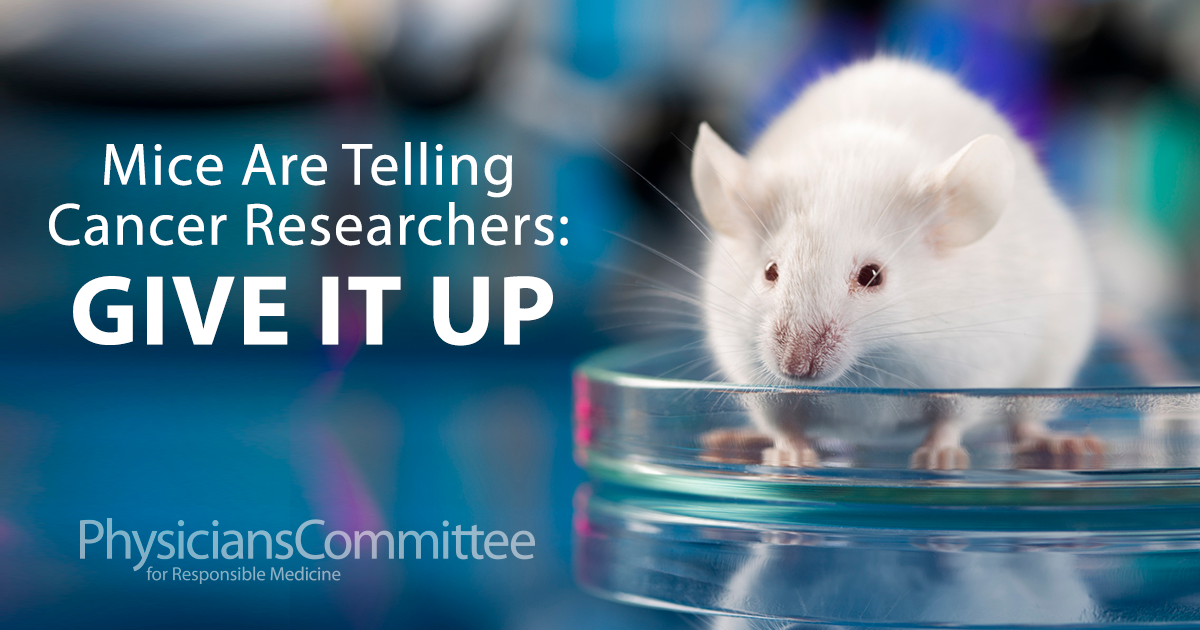Mice Are Telling Cancer Researchers: Give It Up

It is widely known that mouse research to study human cancers is fraught with unreliability. Scientists have for decades attempted to replicate human cancer growth and treatment responses in mice by disabling their immune systems and grafting human-cell-line-based cancers onto them, a model known as a xenograft. These studies have notoriously faulty outcomes. A new report has shown that recent “improvements” to this technique are just as faulty.
In general, cancer animal research (see here, here, and here) has a failure rate of at least 95 percent, as determined by the results of clinical trials based partly on mouse studies. The few "successes" are usually clinically irrelevant, providing minimal or no real-life value. A 2014 study from the National Cancer Institute revealed an average 2.1 month life prolongation (and often as little as a few days) for the 72 cancer drugs approved from 2002-2014, and even this minimal benefit is illusory in two-thirds of the drugs in clinical use.
Researchers characteristically address the very high attrition rate for drugs developed from animal research by postulating that “better” techniques with animals are needed. Various approaches to improve the predictability of these stand-ins for human cancers have been tried without success. In recent years, there has been much hope ascribed to an approach referred to as patient-derived xenografts (here, here, and here). The mice used in these studies are termed PDX mice and are often called human avatars. To produce these avatars, extracts from human cancers (obtained by biopsies or surgical excisions) are injected into mice, thereby creating mice purportedly expressing the injected cancer. These models can be created from a patient's own tumor, in which case the patient then has a “model” specific for his or her own cancer. It has been thought that such "precision oncology" models will remedy the problems with cell-line-derived cancer tissue, and will identify tumor markers, genetic targets, and effective treatments for a patient's specific cancer.
A recent report from Boston researchers reveals why the ballyhooed PDX approach fails to solve the age-old problem of translation from mice to humans—a problem researchers understandably call the Valley of Death. Using 1,110 tissue samples from 24 different cancer types, these researchers evaluated genetic changes occurring after transplantation of patient-derived cancer tissue into PDX mouse avatars.
Genetic changes in the transplanted tumors occurred rapidly, and these were markedly different from initial genetic characteristics and genetic changes observed during tumor evolution in patients. Genetic mutations noted in patient tumors sometimes disappeared after transplantation. The authors concluded: "Notably, the genomic stability of PDXs was associated with their response to chemotherapy and targeted drugs. These findings have major implications for PDX-based modeling of human cancer."
In other words, the human cancer in the PDX mouse's biological environment leads to mouse-specific changes that invalidate the mouse as a descriptor of the human tumor or as a method for identifying tumor targets and developing treatments. It is no wonder that this precision oncology approach displays no more precision than previous failed cancer research methods using mice. Similar genetic discrepancies would surely be expected for any species using PDX technology, and the conclusion remains that nonhuman research is immutably inadequate for the study and treatment of human cancers.
Where to from here? First, it's long past time that we take notice of the many ways that mice have shown us that they are not tiny humans. Despite decades of research model manipulation, mice are no better at recapitulating the course or treatment responses of human cancers. Second, the logical transition to human-relevant cancer research methods is overdue. Whether the barriers to this transition are researcher arrogance, career and funding considerations, or regulatory restrictions, these must be overcome if the abject failure of mouse research for cancer is to be reversed.








